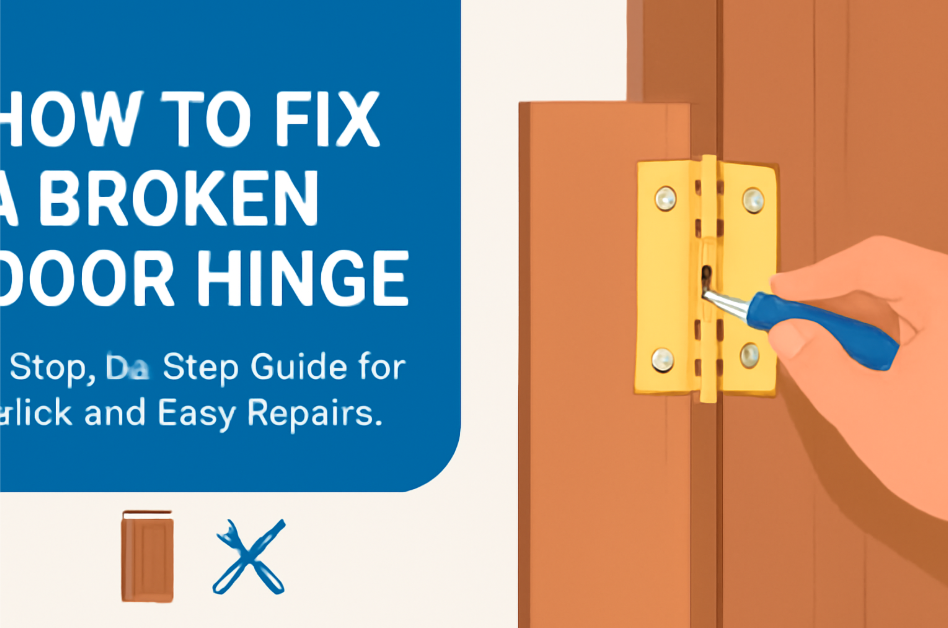
How to Fix a Broken Door Hinge: A Step-by-Step Guide for Quick and Easy Repairs
Have you ever struggled with a door that won’t close properly, makes an annoying squeak, or even feels like it might fall off the frame? 
But don’t worry—fixing a broken door hinge is easier than you might think! In this step-by-step guide, we’ll walk you through everything you need to know, from identifying the issue to repairing or replacing the hinge. By the end of this article, you’ll feel confident tackling this DIY project and get your door back to perfect working order in no time.
So, if you’re ready to save time and money (and avoid the hassle of calling a professional), keep reading! Let’s dive into how to fix a broken door hinge quickly and effectively.
Table of Contents
ToggleUnderstanding Door Hinges and Common Issues
Before diving into repairs, it’s helpful to understand what a door hinge is and why it might break. A door hinge is the metal mechanism that allows a door to swing open and closed. It connects the door to the door frame, supporting the door’s weight and ensuring smooth movement.
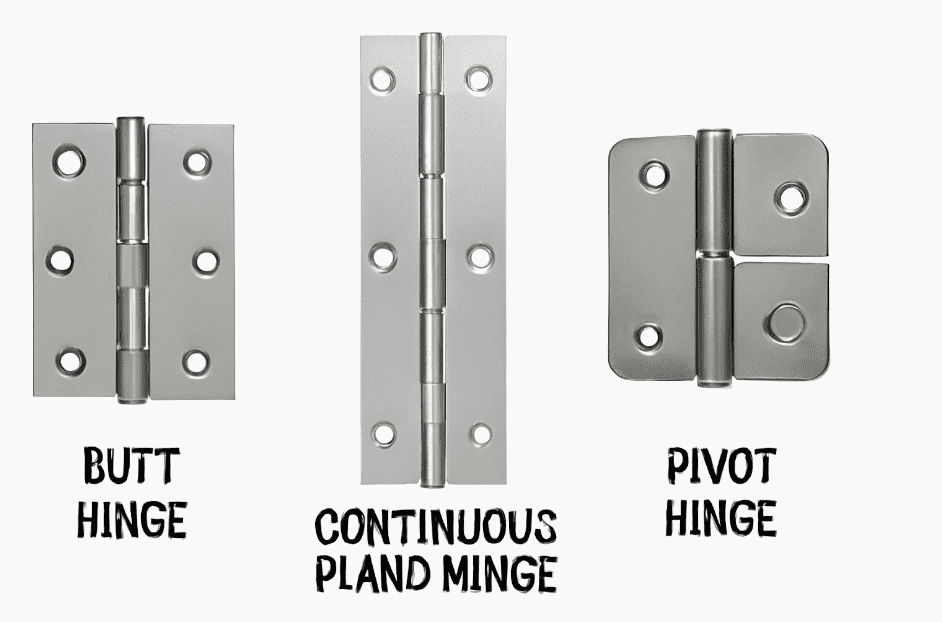
Types of Door Hinges
While there are many types of door hinges, the most common ones you’ll encounter are:
- Butt Hinges: The standard hinge you’ll see on most doors. It consists of two leaves that fit together, with a pin running through them.
- Continuous Hinges: Also known as piano hinges, these run the full length of the door.
- Pivot Hinges: Used for heavier doors or unique door designs.
Common Causes of Broken Door Hinges
Now that we know what a hinge is, let’s talk about why they break or get damaged. Here are a few common culprits:
- Wear and Tear: Over time, door hinges can wear down due to constant movement. The screws may loosen, or the hinge pin may become worn out. This is especially common in high-traffic areas.
- Misalignment: If the door is slammed too hard or isn’t hung properly, the hinges may get misaligned. This can cause the door to sag or not close properly.
- Rust and Corrosion: Hinges exposed to moisture or humidity can develop rust. This not only makes them squeaky but can also weaken their structure over time.
- Loose Screws: The screws that hold the hinge in place can become loose from frequent use. This may cause the door to shift, making it harder to open or close smoothly.
Signs Your Door Hinge is Broken
Not sure if your hinge needs fixing? Here are some telltale signs that your hinge is broken or damaged:
- Squeaking or Grinding Noises: If you hear noises when opening or closing the door, it’s a sign the hinge is rubbing or moving improperly.
- Door Dragging on the Floor: A sagging door can scrape against the floor, causing wear and potentially damaging both the door and the hinge.
- Visible Damage: Cracks, rust, or loose screws on the hinge can indicate damage that requires attention.
- Door Won’t Close Properly: If the door isn’t aligning with the door frame, it may be due to a broken hinge that needs adjusting or replacing.
Tools and Materials You’ll Need
Before you start fixing your broken door hinge, it’s important to gather the right tools and materials. Don’t worry—most of these items are easy to find and affordable. Let’s go over the essentials you’ll need to make this repair as simple and stress-free as possible.
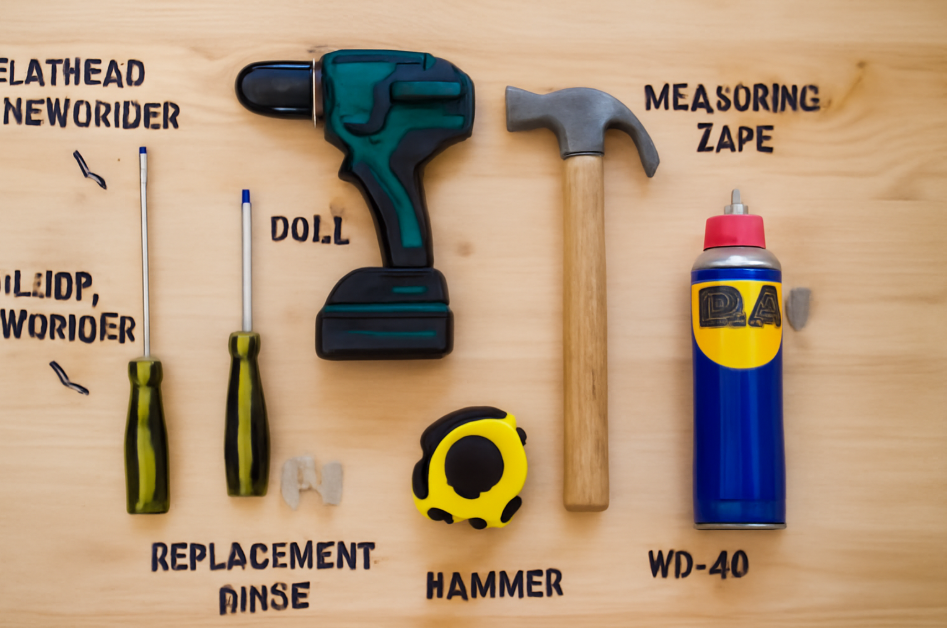
1. Screwdriver (Flathead and Phillips)
You’ll need a flathead screwdriver to pry out any stubborn hinge pins and a Phillips screwdriver to tighten screws. Make sure the screwdriver fits the screws on your door hinge, as using the wrong size can strip the screw heads.
2. Drill
A drill is handy if you need to create new screw holes or if the old ones have become too worn out. If you’re replacing the hinge, you might need to drill new holes in the door or frame to ensure the new hinge fits securely. This tool isn’t absolutely necessary, but it can make the job quicker and easier.
3. Hammer
A hammer will help you gently tap out hinge pins if they’re stuck. Don’t use too much force, as you don’t want to damage the hinge or the door itself. Just tap lightly until the pin comes free.
4. Measuring Tape or Ruler
It’s important to make sure your new hinge is placed in exactly the same spot as the old one. Use a measuring tape or ruler to measure the distance between hinge holes and ensure everything lines up properly.
5. WD-40 or Lubricant
If your hinge is rusty, WD-40 or a similar lubricant will help loosen up stuck parts. It’s also great for preventing future squeaks once your door is back in working order. Just spray a small amount directly on the hinge and wipe off any excess.
6. Replacement Hinge (or Hinge Parts)
If your hinge is broken, you’ll need to buy a new one. Be sure to get the correct size and style to match your door. If just the hinge pin or screws are damaged, you can replace those individually, but if the entire hinge is worn out, a full replacement is the best option.
Where to Get Your Tools
You can find these tools at any local hardware store or online. Many of these items are likely already in your toolbox, so take a quick inventory before heading to the store. If you don’t have a drill or measuring tape, they’re easy to pick up and don’t cost much.
Tip for Saving Money 
If you’re on a tight budget, you don’t have to buy a brand-new hinge every time. Often, you can fix a hinge with just a replacement pin or screws, especially if the rest of the hinge is still in good condition. Check your existing hinge carefully before deciding to replace it completely!
Step-by-Step Guide to Fix a Broken Door Hinge
Fixing a broken door hinge doesn’t have to be difficult! Follow these easy steps, and you’ll have your door working smoothly again in no time. Whether it’s a loose hinge, a broken pin, or a completely damaged hinge, this guide will walk you through the process step by step.
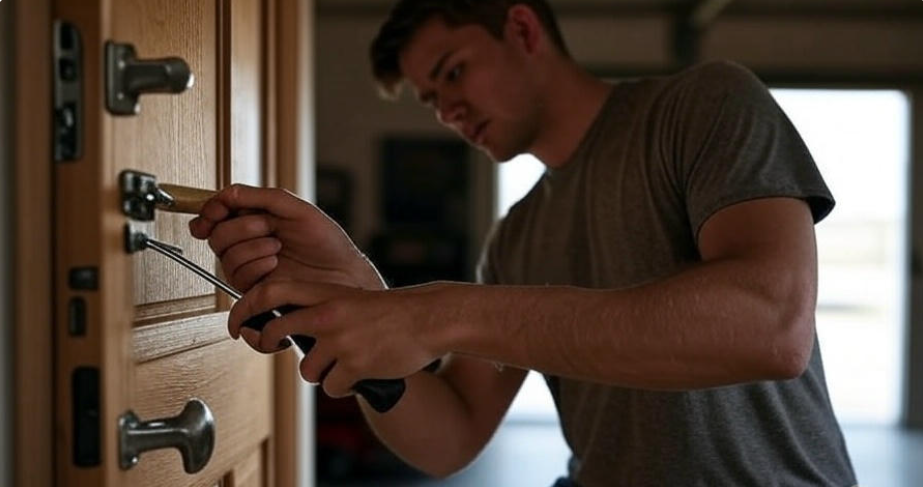
Step 1: Assess the Damage
Start by examining the hinge carefully. Look for any visible damage, such as cracks, rust, or missing parts. Check if the hinge is loose or misaligned, which might be causing the door to sag. If the hinge is severely broken or rusted, you’ll need to replace it entirely. If it’s only loose or slightly damaged, you can likely fix it with a few adjustments.
Step 2: Remove the Door (if necessary)
In some cases, you might need to remove the door to access the hinge. Here’s how to do it safely:
- Loosen the screws: Use your screwdriver to remove the screws holding the hinge to the door frame. Start with the screws on the top hinge, as the bottom hinge will help support the door as you remove it.
- Tap out the hinge pins: If the hinge pins are stuck, gently tap them with a hammer and flathead screwdriver to loosen them. Be careful not to damage the hinge or door.
- Remove the door: Once the screws are loosened and the pins are out, carefully lift the door off the frame. You may need an extra pair of hands for this part, especially if the door is heavy.
Step 3: Fix or Replace the Broken Hinge
- Tighten loose screws: If your hinge is loose, simply tighten the screws using the Phillips screwdriver. Make sure the screws are long enough to grip securely into the door frame. If necessary, replace the screws with longer ones for a better hold.
- Replace the hinge: If the hinge is too damaged to be fixed, it’s time to replace it. Here’s how:
- Remove the old hinge: Unscrew the old hinge from the door and frame. You may need to use a drill if the screws are stuck or stripped.
- Align the new hinge: Place the new hinge in the same position as the old one. Make sure it’s perfectly aligned with the door and frame. Use a measuring tape to double-check the alignment before you screw it in place.
- Install the new hinge: Secure the new hinge by screwing it into place. If necessary, use a drill to make new holes in the door or frame. Ensure the hinge is tightly fastened and the door can swing freely.
Step 4: Reinstall the Door
Now that the hinge is fixed or replaced, it’s time to put the door back in place. Here’s how:
- Align the door with the frame: Carefully lift the door and align the hinge with the corresponding hinge plate on the door frame. If the door feels heavy, get a helping hand for support.
- Insert the hinge pins: Once the door is in place, insert the hinge pins into the hinge. Tap them lightly with a hammer to secure them. Make sure the pins are fully inserted, and the hinge is tight.
- Screw the hinge in place: If you removed screws from the frame or door, tighten them now. Check that the door is level and properly aligned.
Step 5: Test the Door
After reinstalling the door, it’s time to test it! Open and close the door a few times to ensure it moves smoothly. Pay attention to any squeaking or resistance, which might indicate a loose screw or misalignment. If the door still drags on the floor or doesn’t close properly, check the hinge for any adjustments that might be needed.
Troubleshooting Common Issues
Even after fixing your door hinge, sometimes problems can still pop up. Don’t worry—most issues are easy to fix with a little troubleshooting! Here are some common problems you might encounter and how to solve them.
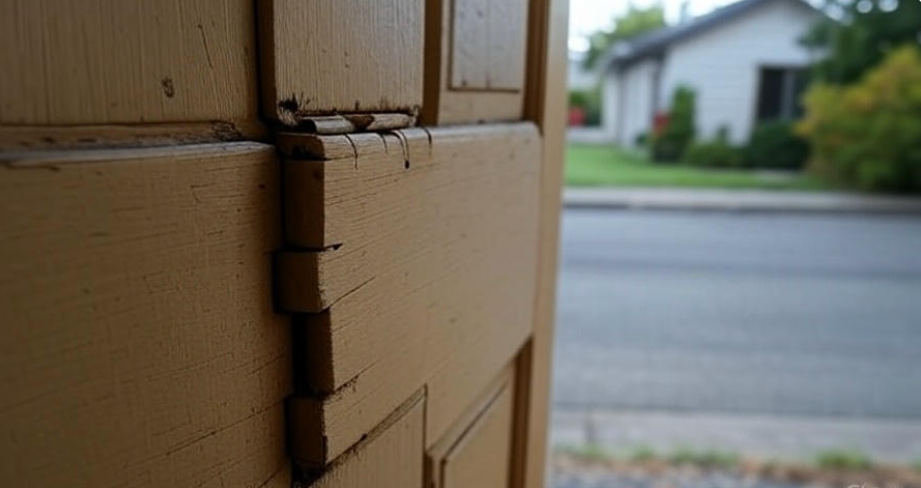
1. Hinge Won’t Stay Tight
If your hinge keeps loosening, it might be because the screw holes are stripped or too large. Here’s how to fix it:
- Use Longer Screws: If the screws aren’t holding, try using screws that are slightly longer. This will give them more grip.
- Fill the Holes: If the holes in the door or frame are too wide, fill them with wood filler or matchsticks. Once the filler is dry, drill new holes for the screws to fit securely.
Tip: If you’re dealing with a heavy door, you might also want to use thicker screws to handle the extra weight.
2. Door Still Doesn’t Close Properly
If the door still doesn’t close as it should, the hinge may not be aligned properly. Here’s what you can do:
- Check Alignment: Double-check the position of the hinge. Ensure it’s aligned correctly with both the door and frame. Use a measuring tape to confirm the distance between hinge holes.
- Adjust the Hinge: If the door is misaligned, loosen the screws on the hinge and shift it slightly. Tighten the screws again once it’s properly aligned.
- Check for Warping: Sometimes, doors or frames can warp over time, causing misalignment. If that’s the case, a professional may be needed to correct the issue.
3. Squeaky Door
A squeaky door is a common complaint and usually easy to fix. This happens when the hinge rubs against the door or frame, causing friction. Here’s how to silence it:
- Lubricate the Hinges: Apply a small amount of WD-40 or a silicone-based lubricant directly to the hinge. Wipe away any excess to avoid drips.
- Clean the Hinge: Dirt and dust can cause squeaks too. Clean the hinge with a cloth before lubricating it to ensure smooth movement.
Tip: Regularly lubricating your hinges can prevent squeaks from returning in the future.
4. Door is Dragging on the Floor
If the door is scraping the floor or threshold, it’s often a sign that the hinge is loose or misaligned. To fix this:
- Tighten the Hinges: If the screws are loose, tighten them and check if the door stops dragging.
- Adjust the Door: If the door is still misaligned after tightening the screws, try adjusting the hinge position slightly. If necessary, add a shim behind the hinge to lift the door.
5. Rusty or Corroded Hinges
Rust can make your hinges stiff, noisy, or even cause them to break over time. Here’s how to deal with it:
- Remove Rust: Use a rust remover or scrub the hinge with steel wool to remove the rust.
- Lubricate: After cleaning, lubricate the hinge to prevent future rusting and ensure smooth operation.
Tips for Maintaining Door Hinges
Once you’ve repaired your broken door hinge, it’s essential to keep it in good working condition. Regular maintenance can prevent future issues, saving you time and effort down the road. Here are some simple tips to help you maintain your door hinges and keep them functioning smoothly.

1. Lubricate Regularly
To keep your hinges quiet and smooth, apply a small amount of lubricant every few months. WD-40, silicone spray, or even petroleum jelly work well. Just make sure to wipe away any excess to prevent it from dripping onto the floor. Regular lubrication prevents squeaks and reduces friction, which helps the hinge last longer.
2. Tighten Screws Periodically
Check your door hinges every few months to ensure the screws are tight. Loose screws can cause the door to sag or misalign, putting extra strain on the hinge. If the screws seem to be loosening frequently, consider replacing them with longer ones for a more secure hold.
3. Inspect for Rust
Rust can quickly degrade the performance of your door hinge. Periodically inspect your hinges for signs of corrosion, especially if they’re exposed to moisture or humidity. If you spot any rust, clean it off immediately using a rust remover or steel wool, then apply lubricant to protect the metal.
4. Keep the Area Clean
Dirt and dust can accumulate on your door hinges, causing them to wear out faster. Use a dry cloth or a small brush to clean the hinge regularly. Keeping the area around the hinge clear of debris will prevent unnecessary friction and wear.
5. Avoid Slamming the Door
Though it might seem obvious, slamming the door can cause unnecessary stress on the hinges. Encourage family members or housemates to open and close the door gently to reduce the risk of damaging the hinges over time.
6. Adjust the Door If Needed
If your door starts to drag or doesn’t close properly, don’t wait too long to make adjustments. Even small misalignments can cause strain on the hinge, leading to bigger issues. If you notice any unevenness, take the time to adjust the hinge position before it becomes a bigger problem.
7. Replace Damaged Hinges Promptly
If you notice any signs of wear, such as cracks, rust, or broken hinge pins, replace the hinge as soon as possible. The longer you wait, the more likely the problem will worsen, leading to more damage to the door or frame.
When to Call a Professional
While fixing a broken door hinge can be a simple DIY project, there are times when calling a professional is the best option. Knowing when to reach out for expert help can save you time, money, and frustration. Here are the signs that it’s time to call in a pro:
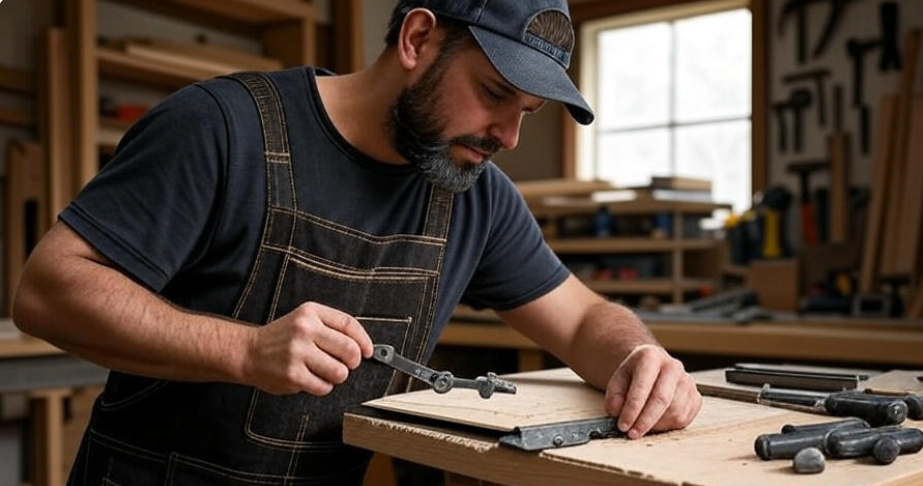
1. The Hinge Is Severely Damaged 
If the hinge is completely bent, cracked, or rusted beyond repair, replacing it might be more complicated than simply tightening screws. A professional can assess the damage and ensure the proper hinge replacement is done without causing further damage to the door or frame.
2. The Door Is Misaligned 
If your door has become misaligned due to a broken hinge, it can cause major problems with opening and closing. If you can’t seem to get the door back into place, a professional will have the tools and experience to adjust the door properly, ensuring it opens and shuts smoothly.
3. You Notice Structural Damage 
If the surrounding door frame or wall is damaged, fixing the hinge may not be enough. A professional can handle structural issues, ensuring that everything is aligned and safe. Structural repairs often require specialized tools and expertise to prevent further issues.
4. You Don’t Have the Right Tools 
While some basic tools may be sufficient for minor repairs, replacing or fixing a door hinge may require specialized tools like door shims, hinge jigs, or heavy-duty screws. If you don’t have access to the right equipment, it’s worth considering hiring a pro to get the job done correctly.
5. You’re Not Sure What’s Causing the Problem 
Sometimes, a door hinge might appear to be the issue, but the problem could be something more complex, such as a misaligned door frame or foundation issues. If you’re unsure what’s causing the problem or how to fix it, hiring a professional can provide peace of mind and prevent making the issue worse.
6. The Repair Is Beyond Your Skill Level 
If you’ve tried fixing the hinge yourself but the door still isn’t functioning properly, or if you’re unsure about how to proceed, don’t hesitate to call a professional. It’s better to seek help than to make an irreversible mistake, especially when it comes to important elements like doors that ensure your home’s safety and security.
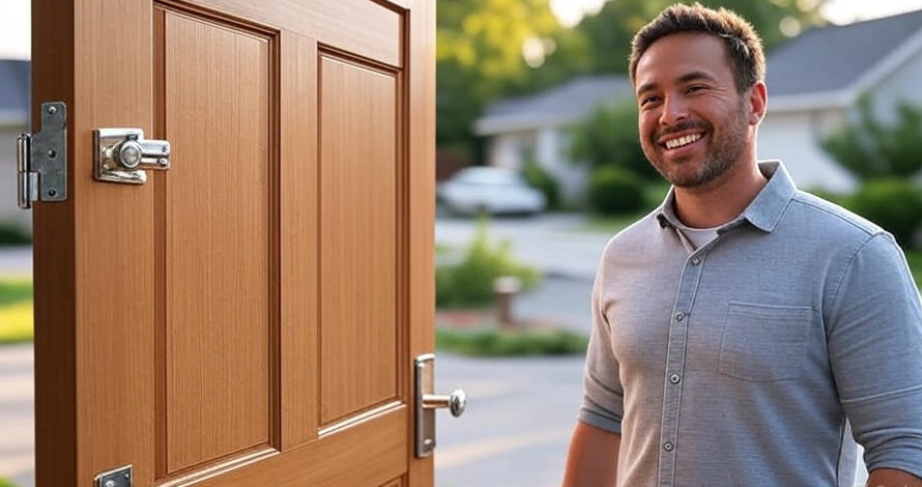
Fixing a broken door hinge may seem like a small task, but it’s one that can make a big difference in the function and security of your home. By following this step-by-step guide, you now have the tools and knowledge to tackle the repair confidently. Whether you’re tightening screws, replacing a worn-out hinge, or addressing more serious issues, it’s important to assess the problem carefully and ensure that you’ve got the right solution.
Remember, while many door hinge repairs can be completed by a DIY enthusiast, it’s always okay to call a professional when the damage is extensive or beyond your skill level. Taking the time to address the issue properly will not only restore the functionality of your door but also extend its lifespan.
With these tips and tricks, you’ll be able to keep your doors in top shape and avoid costly repairs down the line. Happy fixing!
Frequently Asked Questions (FAQs)
1. What causes a door hinge to break?
A door hinge can break due to constant use, age, poor installation, or improper weight distribution. Over time, the screws may loosen, causing the hinge to become misaligned, or the metal can wear out due to friction. High humidity or rust can also contribute to hinge failure.
2. How do I know if my door hinge is broken?
Signs of a broken door hinge include difficulty in opening or closing the door, visible damage like bent or cracked metal, or the door sagging unevenly. If the door doesn’t align with the frame or there are gaps at the top or bottom, it’s likely the hinge is broken.
3. Can I fix a broken door hinge myself?
Yes, many broken door hinges can be fixed by a DIY enthusiast with the right tools. If the hinge is loose or the screws are stripped, you may only need to replace the screws or hinge. However, more severe damage may require hinge replacement or professional help.
4. What tools do I need to fix a broken door hinge?
To fix a broken door hinge, you’ll typically need a screwdriver, drill, replacement screws or hinges, wood filler (for fixing screw holes), and a measuring tape. If the hinge is severely damaged, you may also need a hammer or pliers for removal.
5. How do I replace a broken door hinge?
To replace a broken hinge, start by removing the screws holding the hinge in place. Then, carefully remove the old hinge and replace it with a new one, ensuring it’s aligned with the door and frame. Once in place, reattach the screws and check if the door opens and closes smoothly.
6. What if my door hinge screw holes are stripped?
If the screw holes are stripped, use wood filler to fill them up, allow it to dry, and then drill new pilot holes for the screws. Alternatively, you can use a larger screw or a hinge repair kit to ensure a secure fit.
7. Can a broken door hinge affect my door's security?
Yes, a broken door hinge can compromise your door’s security. If the hinge is not secure, it can cause the door to sag or become misaligned, making it easier for someone to break into your home. It’s important to repair a broken hinge quickly to maintain security.
8. When should I call a professional to fix my door hinge?
If the hinge damage is extensive, or if you cannot fix the problem despite trying different solutions, it’s time to call a professional. Also, if the door frame is damaged or the alignment is off, a professional will have the expertise and tools to make the necessary repairs.











